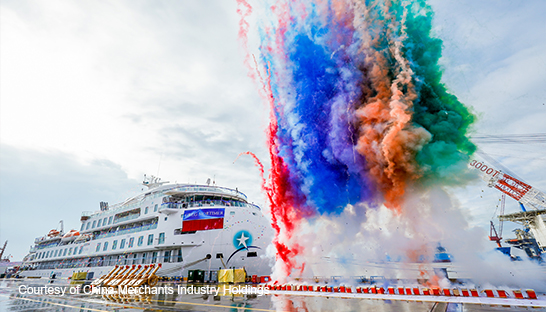China Merchants Cruise Shipbuilding (CMCS) mainly concentrates on the Asian and Chinese cruise markets. There were 2.3 million cruise passengers from China in 2018, and another 1.9 million from the rest of Asia.
The potential in China, in particular, is huge. There are approximately 120 million people in the country with an annual income of $50,000 or more, and the cruise penetration is less than 1% of the population, far below the 3.6% seen in the US.
When it comes to ‘Chinese style’ cruises, there are two aspects where operators look to customise facilities: service and interior design.
In terms of service, passengers from China have their preferred foods, service style, daily habits and activities. Many ships now offer tailored services such as: Chinese food and drink, souvenirs, activities such as Mahjong, square dancing and karaoke. It is important that companies fully respect the needs of Chinese passengers.
There is also the design element. These days we offer a modern aesthetic style, which has replaced features such as a traditional style temple or palace on a ship’s hull. But we expect to see more Chinese-style public areas, offering a modern translation of traditional Chinese architectural design. We are happy to see some of our potential clients already offering such designs.
Ships must also be designed with the sea conditions and port facilities in mind. In China most voyages have a duration of around 5-7 days and many ports require vessels to reserve customs clearance, meaning ships must arrive on schedule. As a result, ships must sometimes run at a speed of more than 18 knots to make up time, which must be considered in the concept design phase.

There is also potential in the fact that Chinese cruising is not yet subdivided into the segments that we see in Europe and the US, for example, small luxury cruise ships, dedicated voyages for older citizens, and long duration voyages.
At CMCS, which was founded in 2017, we are working towards establishing a leading position in the small cruise vessel market, and then step-by-step entering the large cruise market.
At our Haimen shipyard near Nantong, we are building a series of 6 cruise expedition ships for US-based SunStone and delivered the first of these in August 2019. We have had very good feedback on the vessel quality and design.
Our parent company, China Merchants Group, has a wider strategic plan to develop cruise line operations in Asia, Chinese cruise terminals, plus newbuilding and repair. It is discussing potential strategic cooperation with several cruise lines.
We at CMCS meanwhile are following a development path of ‘from small to large, from easy to difficult’. We aim to start with high-end inland river cruise ships, polar cruises, cruise ferries, small and medium-sized cruise ships, and simultaneously develop the manufacturing support chain.
We are building a new weather-independent dock, and facilities with advanced and intelligent manufacturing. The group has the Sci-tech Innovation Platform, Cruise Research Institute in Shanghai and Cruise Ship Technical Center in Haimen. It also owns overseas technical sub-centres including Deltamarin Ship Design and CMIT Europe for interior design.
We believe the cruise ship building industry in Asia currently faces three main challenges: technical risk, supply chain risk, and marketing demand risk.
Construction of cruise ships above 100,000 gt remains a new area for Chinese yards, and we still have gaps in ship design, manufacturing, interior workmanship, quality control etc. We are gradually overcoming this with the aforementioned strategic plan.
Supply chain risk is another big topic. European shipyards can generally obtain 80% or more of the materials, equipment and systems in their local areas, while importing means risk in time control and stock availability.
We are currently building a cruise industry park near our yard, offering plants and factory space for potential contractors with experience, while local government is offering beneficial tax policies.
Finally, market demand risk is clearly currently dominated by the COVID-19 outbreak. Incidents onboard cruise ships in early 2020 impacted confidence, and as a result we have some concerns about ordering volume in the next 2-3 years. We expect it could take between 1-3 years to recover from the full impact of COVID-19.
Ideally, the cruise ship is something that brings the passenger happiness. The most important elements for shipbuilding are delivery time, and that passengers are satisfied with the ship and the product. Cruise ships are a resort, a travel destination in their own right, and we are part of the travel business rather than the transport industry.

BIOGRAPHY
Zhengjun Tian is the Director of Cruise Projects at Hong Kong-based China Merchants Industry Holdings Co. Ltd, where he is responsible for the marketing and sales of cruise projects, including newbuilding and renovation. He is also responsible for China Merchants’ Cruise Research Institute’s passenger ship technical centre.
Zhengjun is a naval architect, having graduated from Shanghai JiaoTong University in 1991. Prior to joining China Merchants, he spent 7 years as a surveyor for China Classification Society, and 12 years at AVIC shipyards where he was responsible for special project development, ship design and project management. He also spent 10 years advising European shipowners on newbuilding site project management.
Zhengjun is a specialist in chemical and LNG carrying / fuelled ships, as well as cruise and passenger ships. He is a serving member of RINA’s China Technical Committee.